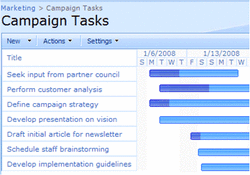
A team can use a calendar to track team events, vacations, and conferences, and other events. Team members can connect this calendar to Microsoft Office Outlook 2007, where they can overlay it with their personal calendars to avoid scheduling conflicts. They can copy events back and forth between the calendars.
The team can use tasks lists to manage the work for large projects, such as planning a convention and managing a marketing campaign. Tasks can be set up with a standard list view or as a project tasks list. A project tasks list provides a visual overview, known as a Gantt view, of the tasks and their progress. Templates are available for creating lists in either format — a standard list view or a project tasks list.
The team can use an issue tracking list to track logistical problems that are related to the conference planning, such as registration database issues. A team member logs the issue, and then people record any updates and fixes until the issue is resolved.
Working with lists
When you create a team site, several lists are created for you. These default lists range from a discussion board to a calendar list. You can customize and add items to these lists, create additional lists from templates, and create custom lists with just the settings and columns that you choose.
Lists can include many types of information, ranging from text to dates to pictures. Lists can also include calculations, such as totals or a calculated date, such as a week from today's date.
By using lists, you can do the following:
Track versions - You can track versions of list items, so that you can see which list items have changed, as well as who changed them. If mistakes are made in a newer version, you can restore a previous version of an item.
Require approval - Your organization can specify that approval for a list item is required before it can be viewed by everyone.
Integrate e-mail with a list - If incoming or outgoing e-mail is enabled on your site, some lists can take advantage of e-mail features. Some types of lists, such as calendars and discussions, can be set up so that people can add content to them by sending e-mail. Additionally, Office Outlook 2007 integrates with calendar, tasks, and contacts lists.
Customize permissions - Your organization can specify custom permissions for a list or even a single list item. This feature can be useful, for example, if a specific item contains confidential information.
Create and manage views - Your group can create different views of the same list. The contents of the actual list don't change, but the items are organized or filtered so that people can find the most important or interesting information.
Keep informed about changes - You can subscribe to RSS Feeds of lists and views to see updates to lists in your RSS viewer, such as Outlook 2007. If your organization has set up incoming e-mail, you can receive e-mail alerts when items change.
Manage lists and work offline with lists in Microsoft Office Access 2007 - You can manage lists with database tools and take lists offline with Office Access 2007.
View lists on mobile devices - You can view many lists, such as tasks lists and calendars, and document libraries on mobile devices. To view a mobile list, type /m after the Web address of the site. Mobile views are not available for some list types, such as discussions, and may not display all column types.
Common types of lists for collaboration
The following are some of the more common types of lists your organization can use:
Calendar - Use a calendar for all of your team's events or for specific situations, such as a project calendar or company holidays.
Tasks and project tasks - Use a tasks list to track information about projects and other events for your group. You can assign tasks to people, as well as track the status and percentage complete as the task moves toward completion. A project tasks list displays the tasks with progress bars, known as a Gantt view.
Issue tracking - Use an issue-tracking list to store issues, their status, and resolution. This is a common type of list for tracking support issues or incidents, such as customer service, quality assurance, or technical support.
Discussion boards - Use a discussion board to provide a central place to record and store team discussions that is similar to the format of newsgroups.
Announcements - Use an announcements list to share news and status and to provide reminders.
Contacts - Use a contacts list to store information about people or groups that you work with.
Links - Use a links list as a central location for links to the Web, your company's intranet, and other resources.
Surveys - Use a survey to collect and compile feedback, such as an employee satisfaction survey or a quiz.
Custom - Although you can customize any built-in list, you can start with a custom list and then add just the settings that you want. You can also create a list that is based on a spreadsheet, such as a Microsoft Office Excel 2007 workbook for managing contracts.
 RSS Feed
RSS Feed
